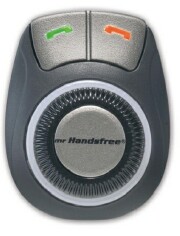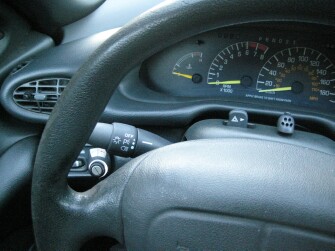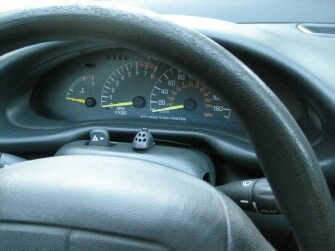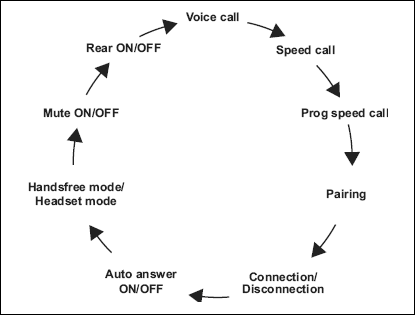
Here in California this year, the top Christmas gift for adults may turn out be the hands-free carkit. As of January 2008, talking on a handset while driving officially becomes a moving violation. And while there’s ongoing debate over just how much safer hands-free operation is than simply staying off the line while driving, the former is clearly the lesser of two evils—and unquestionably more comfortable.
Many cell phone users still resist Bluetooth headsets, either to avoid looking like a cyborg, or to avoid the discomfort of extended wear. They only need hands-free operation while driving, when both hands are occupied.
Older car stereos can be replaced with Bluetooth-enabled units, but if you like your current stereo, it may be more cost-effective to simply add Bluetooth. In my case, it wasnÂ’t. My Dual XDM 6400 has Bluetooth, but only supports A2DP out of the box. I had to buy the manufacturerÂ’s proprietary adapter to support the hands-free profile. The beauty of the Blue Smart is that it works with any car stereo, and can even work without a stereo, thanks to the unitÂ’s integrated speaker.
Design

Included in the box for the mr Handsfree Blue Smart (yes, that’s a lower-case “mr”–sans period) are three operational components: the handsfree unit, the remote control, and the microphone; two installation support components: the power connections and fixation pieces (screws, clips, double-sided tape); and documentation: a printed Quick Reference Guide and a CD with the full manual on PDF.
As the name suggests, the handsfree unit is the heart of the product. It’s a black box with an integrated speaker and four jacks: one for the microphone, one for the remote control, one for the power connection, and one for an external speaker connection. If you have the unit wired according to the optional “Professional built-in connection,” the integrated speaker is switched off when the external speaker is used.
The handsfree unit can be mounted near the dashboard with either the screws or double-sided tape included. In the Ikea tradition of miserliness, mr Handsfree tortures his customers by giving them just enough screws and adhesive materials to do the job. If youÂ’re assembling a desk, thereÂ’s usually only one right way, but when youÂ’re placing a microphones and speakers, the first locations you choose may not be your last. Bad placement between the microphone and speaker can result in echo and feedback nastiness. Before trying to install this, go to the hardware store and get some Velcro.

The microphone is mounted separately. I mounted mine directly behind the steering wheel, away from vents. The microphone has a two-positional button for adjusting its sensitivity. I was surprised at how much difference in outgoing sound quality this button made. When switched to high sensitivity, several people on the receiving end complained about the sound. At low sensitivity, no one complained.
The remote control is deceptively simple-looking. ThereÂ’s a multi-function knob (also referred to as the central button), a call/answer button, and an end/reject button. The knob is used to adjust the volume during a call. Pressing the knob/central button activates a voice menu. Turning the knob navigates to the desired selection; pressing the knob again confirms the selection.
Installation
The Blue Smart has three installation options: a “Plug & Drive” installation and two “built-in” connections. The Plug & Drive installation is by far the simplest method, and the least elegant. The handsfree module is powered by plugging an adapter in the cigarette lighter, and the incoming sound pipes through the internal speaker exclusively. The first built-in connection (that’s “built-in connection” as opposed to “professional built-in connection”) operates directly through the car’s electronic system, muting the radio while the Blue Smart’s speaker is active. The professional built-in connection mutes the car stereo’s normal output during a call, but uses the stereo’s speakers for voice output instead of the Blue Smart’s speaker. Since I already have handsfree apparatus installed through my car’s electronic system (a Dual XDM 6400 car stereo with a Bluetooth adapter), I tested the Blue Smart with the Plug & Drive setup.
With the Plug & Drive setup, plugging the adapter into the cigarette lighter switches the Blue Smart on and off. Both built-in connections are powered on and off automatically through the car’s ignition line. The Bluetooth connection restores automatically when the power is switched on. There’s a “Disconnection” option on the voice menu if you need to disconnect the Blue Smart to re-pair the Treo to another device, like a headset.
Regardless of what setup you choose for your permanent installation, itÂ’s not a bad idea to start off with the Plug & Drive method, testing the remote control, acoustics and component placement before committing to a final mounting. And unless youÂ’re experienced with car stereo installations, itÂ’s also not a bad idea to opt for the professional built-in connection and have it installed by a professional if it costs less than half the Blue SmartÂ’s price.
Setup, Configuration and Operation

All of the Blue Smart’s functions are accessed through the voice menu on the remote control. Once you get the hang of using it, it’s not complicated, but it does take some getting used to. As mentioned above, the typical navigation cycle is: press button, turn button to function (the voice menu calls out the functions as you turn the dial—e.g., “Pairing” or “Speed Dial”), then press again to select function. This interface allows the Blue Smart to cram quite a few configuration options into a very compact controller. The drawback is that using it while driving can distract some of your attention from the road. If you’re using the Speed Dial feature, for instance, you have to dial incrementally as the voice menu calls out each preset until you reach the desired selection. Fortunately, the Blue Smart supports tags on phones with voice dialing.
The pairing process, using the voice menu, looks like this:
- Press button to activate menu
- Turn button to “Pairing”
- Press button to select.
- A voice prompt will say “Activated.” Red and green LEDs will flash alternately
- Search for BT device on Treo
- Select Blue Smart from list and enter “0000” passkey
- When pairing is successful, LEDs will light continuously
I wonÂ’t go into the details of each voice menu operation, but itÂ’s worth pointing out a key one: setting up Speed Dial. Using Speed Dial is easy enough, but programming each number takes a few minutes, requiring the following:
- Press button and navigate to “Speed Dial”
- Press to confirm
- Confirmation tone and voice prompt “One” follow, indicating first memory location
- Turn button through corresponding voice prompts to desired location to store number
- Press to confirm
- Confirmation tone and voice prompt follow—Blue Smart is ready to accept number
- Turn button to corresponding voice prompt for first digit to enter
- Press to confirm
- Repeat procedure to enter the remainder of number
- Press the green button to confirm number entry
Despite being fairly labor-intensive on the front end, it’s much easier—and much safer—to use the remote controller’s speed dial than dialing directly from the Treo without voice dialing.
On a Treo with voice dialing, you do need to go through the extra step of selecting the “Voice Dialing” menu prompt on the controller prior to each voice dial, but it’s not too inconvenient. A big advantage to Voice Dialing is that you’re not limited to the Speed Dial’s 10 presets
Sound Quality
As previously mentioned, I tested the Blue Smart’s Plug-and-Drive setup, not the built-in connections, so I can’t comment on the sound quality through car stereo speakers (which would most likely depend on the particular speakers anyway). My Dual XDM 6400’s setup resembles the professional built-in connection—through the car speakers with the handsfree unit’s speaker disabled. It’s definitely worth spending the extra money to have the professional connection installed, if the Dual is any indication.
The Blue Smart’s internal speaker, however, is better than average. My car is noisier than Prius-era vehicles, and the speaker provides enough reinforcement in the bass end, even at relatively low volumes, to compete with the engine at highway speeds. It’s a little weak in the high midrange, so it still sounds like a speakerphone compared to the professional built-in alternative—but a good speakerphone that’s easily heard above the din of a typical car. My first attempt at installing the Blue Smart resulted in bad reviews of the sound quality from a couple of friends on the other end. Once I repositioned the microphone, opinions of the sound were all “good” (unlike wine critics, my friends don’t describe things with a thesaurus).
Conclusion
The remote controller is a moderate hassle to learn and program, but well worth it afterwards in daily use—especially the speed dialing without having to glance back and forth between the road and the Treo.
If you like your existing car stereo, but it lacks handsfree capability, the mr Handsfree Blue Smart is a smart upgrade, especially if you can manage the professional built-in connection. The Plug-and-Drive connection is an extremely simple installation, and the speaker quality is good enough to make the convenience of setup worth forgoing the built-in connection if youÂ’re more of a pragmatist than an audiophile.
|
|
| Pros |
Versatile remote control operation
Works independently or through stereo unit
Good voice quality from integrated speaker
Flexible mounting options for components
Easy to use once learned
|
|
| Cons |
Voice menu has steep learning curve
Components� flat mounting surfaces hard to attach to contoured interiors
No surplus screws or adhesives for remounting |
|